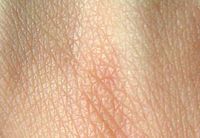
Photo from wikipedia
The article by Dadzie and colleagues entitled ‘The Eumelanin Human Skin Colour Scale: a proof-of-concept study’ proposes a five-point scale to describe human constitutive skin colour. The goal is to… Click to show full abstract
The article by Dadzie and colleagues entitled ‘The Eumelanin Human Skin Colour Scale: a proof-of-concept study’ proposes a five-point scale to describe human constitutive skin colour. The goal is to standardize the descriptive terminology and account for the diversity and heterogeneity of skin colour globally. The authors use eumelanin, the predominant chromophore of human skin, as the reference point. The Eumelanin Human Skin Colour Scale (EHSCS) is based on monthly focus discussions and a literature review by a specialized and diverse dermatology lexicon group that has used skin reflectance data with known range of melanin index (MI) for well-referenced indigenous populations to define the five categories of the EHSCS. These are quantiles Q1 to Q5 for MI values < 25; 25 to < 50; 50 to < 75; 75 to < 100; and ≥ 100. This allows precise quantitation of the range and diversity of skin tones, truly reflective of all populations without any race-based inferences. In essence it is a measurement of skin colour on a gradient and the conceptual simplicity clearly illustrates the authors’ vision. We agree with the authors that the Fitzpatrick skin typing scale, originally intended to be a guide to predict the sensitivity of ‘lighter skin’ to ultraviolet A, has evolved as the most widely used classification to describe human skin colour. By comparing the EHSCS with the Fitzpatrick skin typing scale they have rightly averred that the latter oversimplifies the diversity of dark skin colour by lumping them into cohorts of skin type IV to VI. The EHSCS evaluates skin colour objectively by using the MI as opposed to the Fitzpatrick skin typing scale, which gives functional information and assesses the skin colour subjectively. The authors have proposed a possible modification would be to incorporate the individual typology angle (ITA) system of skin classification with the MI, which addresses the functional aspects of human skin and makes it more inclusive. Such an integrative exercise may be challenging for creating a system that will be sans racial overtones, particularly in skin types on which tanning has significant effects. The conventionally used upper inner arm for example, to calibrate and validate the measurement of eumelanin in vivo, may lead to assignment of different skin colour to workers in indoor and outdoor locations. We therefore feel that the buttock would be a more appropriate site for accurately measuring baseline MI. Validation of the EHSCS across all skin types has been suggested before its use in dermatology practice because of a lack of standardization in reporting MI values. Furthermore, their concept of indigenous people before ‘the modern era of migration, industrialization and urbanization’ will need further clarification and revision. Although Dr Fitzpatrick would not have envisaged the use of the Fitzpatrick skin typing scale to categorize skin colour besides its intended use for phototherapy, the present attempt to standardize skin colour measurement, while minimizing racial subcurrents, is to be applauded. We as dermatologists know that skin types are not only determined by skin colour but also by hair types that need to be integrated into the system to give the ITA depth. These together with categorization of reaction to tanning and inflammation, will help the EHSCS achieve the desired conceptual depth to make it medically and intellectually tenable. Introduction of this system will thus serve as a platform to refine and develop new comprehensive scales to define the range of constitutive human skin colour.
Journal Title: British Journal of Dermatology
Year Published: 2022
Link to full text (if available)
Share on Social Media: Sign Up to like & get
recommendations!